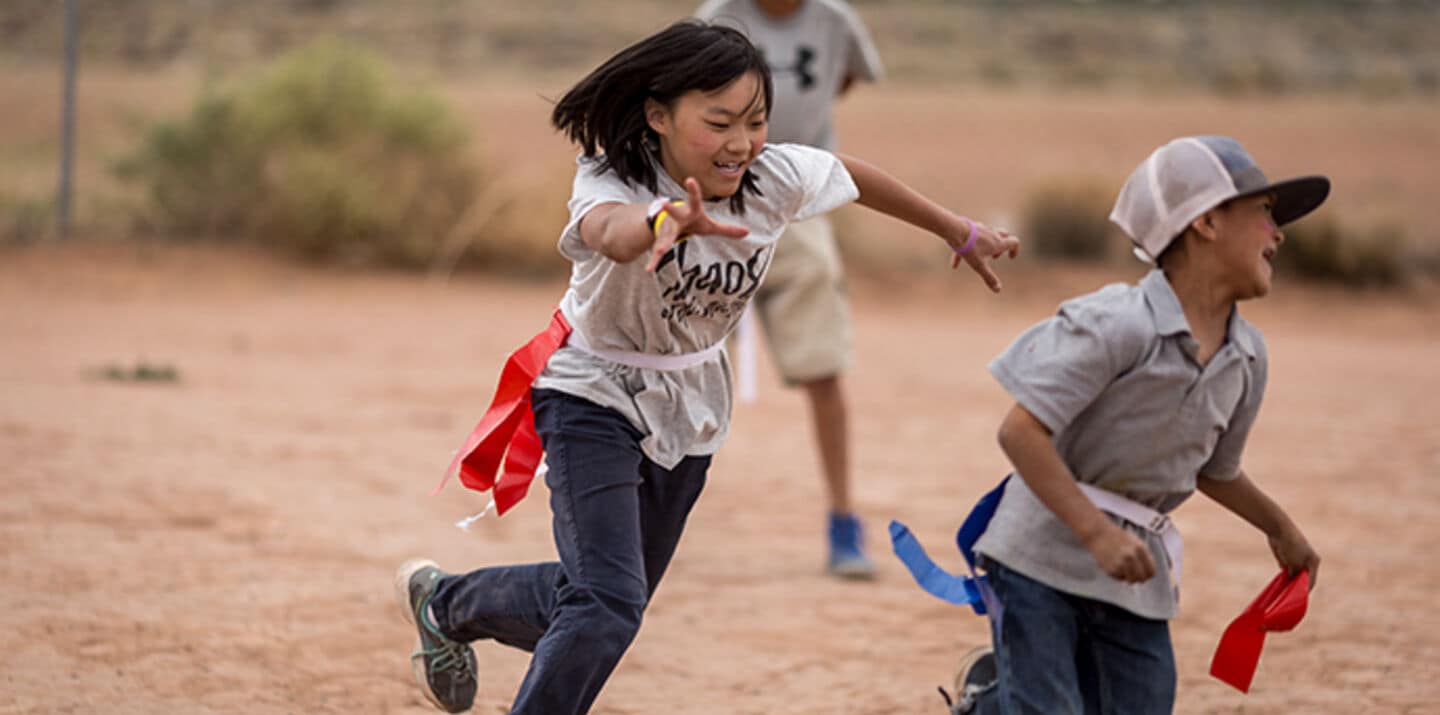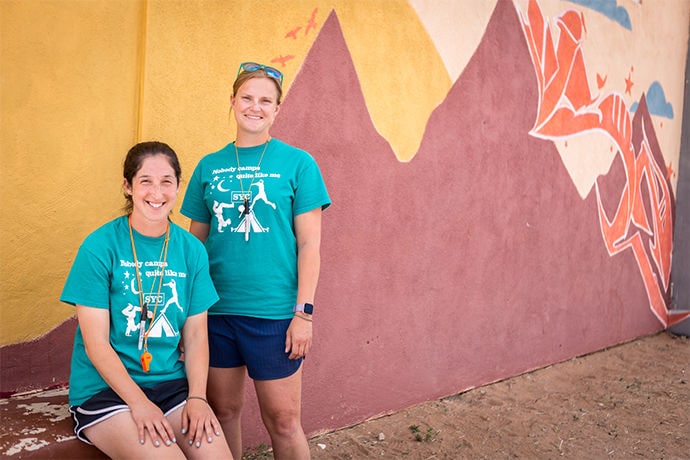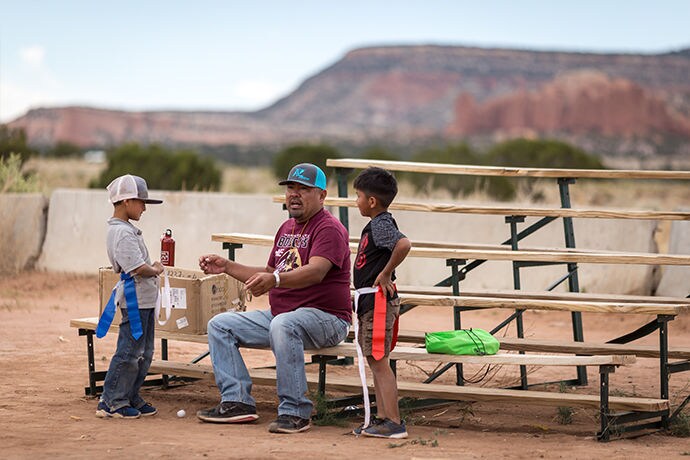
Reinventing Camp Culture: When Kids, Community, and Sovereignty Come First
Dlǫ́ǫ́ʼ Yázhí (Little Prairie Dog) Day Camp is the real deal: a summer camp for Navajo kids from which other camps could take a lesson in authenticity.
Valerie Johnson grew up on the Navajo Nation Reservation in rural northwestern New Mexico, where she still lives in the town of Crownpoint and works in the school dormitory for children who attend Mariano Lake Community School.
Johnson remembers having two broad options during her childhood summers. She could hang out alone or hang out babysitting a few cousins. “There was nowhere to go,” Johnson said.
That’s not an exaggeration. This is a landscape where kids can be isolated from their nearest neighbors by 30 miles of rock and dirt. And not every family has a car or money for gas, which is one of many reasons families choose to board their kids at school.
For her three children, Johnson wanted better summer opportunities than she had.

Four years ago, she found one when she became a counselor (now a director) on the team that launched the Dlǫ́ǫ́ʼ Yázhí (Little Prairie Dog) Day Camp, a free summer camp for kids ages 4 and up, most of whom live in Diné families in and around Thoreau, New Mexico (just east of the Navajo Nation’s borders).
At the camp, kids go on nature hikes to pick plants to make dyes. They go to cooking lessons and learn candle making and wood burning. They play the favorite local sport, basketball. On a typical 90-degree day, you might see 50 kids running in and out of the donated space, a community center where dirt constantly blows through the open windows. They’re enjoying themselves with hand-me-down and donated materials, using markers in the ground as baseball bases, inventing games like taping secret messages to each other’s backs.
“Our camp isn’t flashy,” says one of its cofounders, Leah Strelsin (New Mexico ’11). “We’re really messy.”
The camp (originally the Summer Youth Corporation, now renamed Dlǫ́ǫ́ʼ Yázhí, the Diné translation of Thoreau’s nickname, Little Prairie Dog), is a haven in different ways for each of its 60 campers. For one boy, it’s a place to secure a lunch in the summer. For another, it’s a brief respite from a volatile home.
For 7-year-old Raelynn Yazzie, camp is her place to see other kids’ faces. Where she lives on a mountainside, there isn’t a neighbor for miles, and her mother is frequently focused on a relative with a disability who lives with them. Here at camp, Raelynn is the lively center of her friend circle.

Leah Strelsin and Claire Opel (New Mexico ’10), who taught at the Mariano Lake Community School, both went to summer camps as kids. Camp was foundational in their development. At their placement school, they felt they had limited freedom and opportunity to build lessons around students’ social and emotional learning. They imagined a place that would perfectly fill those gaps: camp.
One day, Strelsin sent her carpool buddy Opel an email with the subject line “Let’s actually do it.” Opel replied with one word: yes.
For camp to reach as many kids as possible in the struggling communities around Thoreau, Opel and Strelsin knew it would have to be free. For it to be meaningful, it had to be rooted in Diné culture and beliefs, with local voices guiding the effort. This would be nothing like the many American camps that mimic (or invent) tribal cultures and traditions without serving American Indian kids.
Opel and Strelsin did not know how to fundraise. They did not really know how to organize. But they learned. And as white women from Denver and Chicago who saw their roles as providing the start-up energy and then stepping back, they are passing to Valerie Johnson and her colleagues everything they’ve learned about the mechanics of running a camp, from finances to program planning.
In 2015, on the day camp opened, not a single kid was officially registered. But Valerie Johnson showed up with her kids. So did Nate Woodie, a Diné teacher whom the founders had met at Mariano Lake Community School and who now guides the camp curriculum. By the end of the 2018 camp season, more than 100 local kids had been to camp, or about 7 percent of the area’s school-aged population.
Now Opel, Strelsin, and camp leaders have a goal of getting at least half the kids in the community to experience the camp’s exploratory learning curriculum by 2022, either through the summer camp experience or by integrating “camp curriculum” into local schools. They are also working to influence camps nationally. The Dlǫ́ǫ́ʼ Yázhí Day Camp is a member of the American Camp Association (ACA), which accredits thousands of camps. The Thoreau contingent is working with other camps to organize a Native Camp Alliance within the ACA. In addition to elevating the problem of other camps appropriating without understanding indigenous traditions and beliefs, they want to share resources and mentor founders to make camps like this one less scarce in and around the lands of sovereign indigenous nations.
“Among the camp world, we get raised eyebrows when people hear what we’re doing,” Opel says. “We know it’s different, but we know it’s worthwhile. I know it’s the best thing I’ve ever done with my life.”
In part due to their burgeoning influence, Opel and Strelsin this year won (on their fourth try) the Teach For America overall track Social Innovation Award, recently named for Arthur and Toni Rembe Rock. It comes with $100,000 that could help establish the camp as a rarity in this region: a resource with a feeling of permanence.
In their award application, the founders cited hard evidence that campers grew in self-esteem, connectedness, and resilience, meeting the benchmarks for competence set by the ACA. The number of kids who could name one positive quality in themselves more than doubled from the start to the end of camp. This summer, leaders set to work on campers’ problem-solving skills.

A Day (and Night) at Camp
During its six-week session, camp doesn’t get going until about 8:30 a.m. But it’s around 6 a.m. when Strelsin and Opel usually head out onto Interstate 40. They know this stretch of road well because every day they pick up and drop off campers who can’t find rides into Thoreau.
It’s a lot of driving, and a lot of gas burned, but “we get to hear the kids in the back seat talk about what they’re excited to do that day or which counselor they want to hang out with the most,” Opel says.
They also check in with families and find out which kids might need to bring home a few extra brown bags for dinner, or who might need a place to stay for a few nights.
When their unofficial camp-chauffeur duty is over, Strelsin and Opel are mostly hands-off for the rest of the day, joining in with kids to practice dances with a cheer group or run up and down court during capture the flag.
Valerie Johnson and her team lead the activities. Nate Woodie consults, even on simple singalongs, to make the space inclusive. “There are certain things Diné kids cannot do, say, touch, or see,” he says. Dances or rhymes that mention snakes or bears are off limits. So is using string for activities during certain times of the year. Images or mentions of certain animals are believed to be bad omens that can cause people physical or mental harm.

The camp operates mostly out of the Thoreau Community Center, which was founded by a former teacher, Juliana Ko Arsali (New Mexico ’08). Diné artwork adorns the walls. A sign reads, “Don’t let our language die.” Most campers live in homes where a mix of English and Diné is spoken. At camp, kids speak the occasional Diné-English phrase. It’s just like home.
Campers here are organized into crews based mostly on age. The youngest crew members are called the “small and mighties.” The oldest crew, ages 12 and up, are the “pathfinders.”
Counselor and Arts Specialist Israel Gonzales moved up with his crew this past summer as they aged from torchbearers to pathfinders. “Watching campers grow as leaders from one summer to the next is my favorite part,” Gonzales said. “I like spotting the kids who don’t realize they’re natural leaders [when they] start to shine.”
Each summer ends with an overnight camping trip to a park in the Cibola National Forest. On the trip, the pathfinders set the pace for the younger crews. The pathfinders went first in making the challenging 360-foot climb up the McGaffey Lookout tower. They waved to the younger kids from the top, then ran down to describe the view of Navajo Nation as far as the eye can see. That’s when a few of the younger kids decided they could handle the climb.
When campers are on the basketball court or playing some version of musical chairs, the sound of their laughter and chatter fills every space. But counselors also regularly gather kids for quieter reflection time in small group circles. That’s when kids revert to the shy versions of themselves.
At camp, kids are asked during activities to stay attuned to their mental, physical, social, and self-reflection strengths. The four self-awareness components, or “folds” as they are called at camp, align with the Diné concept of living in balance. As the day wound down during the campout, Opel asked a circle of campers, “Who wants to say what fold they used today?”
Met with silence, a few counselors answered first. Then one camper volunteered. Then the next camper in the circle repeated a version of the previous camper’s response to get it over with and escape the spotlight.
Each camper ended up saying a few words. They were trying. And that’s progress.

Later, inside their tent, Raelynn Yazzie and 6-year-old Bailey Johnson pulled out press-on tattoos they brought to share with their tentmates. Before leaving for the camping trip earlier that day, Raelynn had asked her mother, Monique, over and over, “Is it time yet? Is it time yet?”
Camp gives Raelynn the attention her mother can’t always provide. “She doesn’t normally talk to me or express herself,” Monique Yazzie said, “but camp brings out a different person in her.” Raelynn recently told her mother she’s going to teach her how to make banana pancakes.
Nate Woodie and Valerie Johnson hear similar stories from other parents. It reaffirms for Woodie that even though circle time and reflection is hard for many kids, when they’re here, “they feel supported, loved, and heard.”
Johnson also sees a difference between campers and other students at her school. “Schools represent boundaries to them, and then they come here, and they feel more like themselves. I can see it carry over when we go back to school, and then I have this great new rapport with students because they remember me from camp.”
She’s seen the changes in her own kids, 12-year-old Matthew and 11-year-old Alice. They became sad and withdrawn six years ago when their father died. Nothing seemed to work on their spirits like camp, Johnson said. Now, Matthew is talking about going to college, and Alice is embracing the parts of her personality that she thought made her weird and an outsider.
This camp is building a culture around passing on advice, traditions, and leadership. Kids who are campers today will have the opportunity to become counselors. On the night of the camping trip, when darkness fell and the younger crews went off to sleep, the torchbearers and the pathfinders met in a small huddle in the middle of the woods. It was time for the annual ceremony where the older crew gives advice to the younger ones who will join them the next summer as leaders.
On one side of the huddle, Matthew Johnson, a pathfinder, held a flickering candle. He looked across the circle at his sister, Alice, a torchbearer, and walked toward her, guarding his flame with his hand.
“Will you carry the light?” Matthew asked. Alice responded, “I will carry the light.” Matthew touched his candle’s flame to the wick of his sister’s candle to make the circle a little brighter.
Do You Have an Idea You Want to Turn Into Action? Claire Opel and Leah Strelsin Have Some Advice — Whether You’re an Expert or a Novice
Claire Opel (New Mexico '10) and Leah Strelsin (New Mexico '11) were teachers who wanted to launch a free summer camp for kids in the Navajo community in and around Thoreau, New Mexico. They had no experience. Naturally, their first step was to Google “how to start a camp.”
“You don’t have to be an expert or have formal knowledge to do something new, as long as you are humble and not afraid to look stupid and ask obvious questions,” Strelsin said. After a few more Google searches (“how to make a camp a nonprofit”) and some light reading (The Business of Camp by Ann Sheets and Dave Thoensen), they were ready for their first fundraiser: a GoFundMe page.
From the get-go in Thoreau, Opel and Strelsin collaborated with community members who used word of mouth to build local support for the camp idea. Together they raised their first rounds of investment through a local basketball tournament fundraiser and by selling fry bread and T-shirts. Opel and Strelsin tapped their hometown friends-and-family networks to solicit donations. They created an Amazon wedding registry to gather gifts of paint and toys. They didn’t pretend to be sure they were doing anything right, and that’s how they managed to keep from getting those first steps completely wrong.
“Don’t research yourself into a panic,” Opel said. “It’s really easy to find a reason why you can’t do something if you go looking for it. Leah and I succeeded because we didn’t know what we were doing and we took it step by step. The logistics fell into place.” And they stuck to their values, tapping their personal time, connections, and assets to seed a community institution led by community members.
The way Opel and Strelsin see it, you don’t have to be an accomplished visionary to build something outstanding. First comes the need, then the idea in response, then someone to start the ball rolling. “It happens in reverse,” Strelsin said.
Sign up to receive articles like this in your inbox!
Thanks for signing up!
Content is loading...


